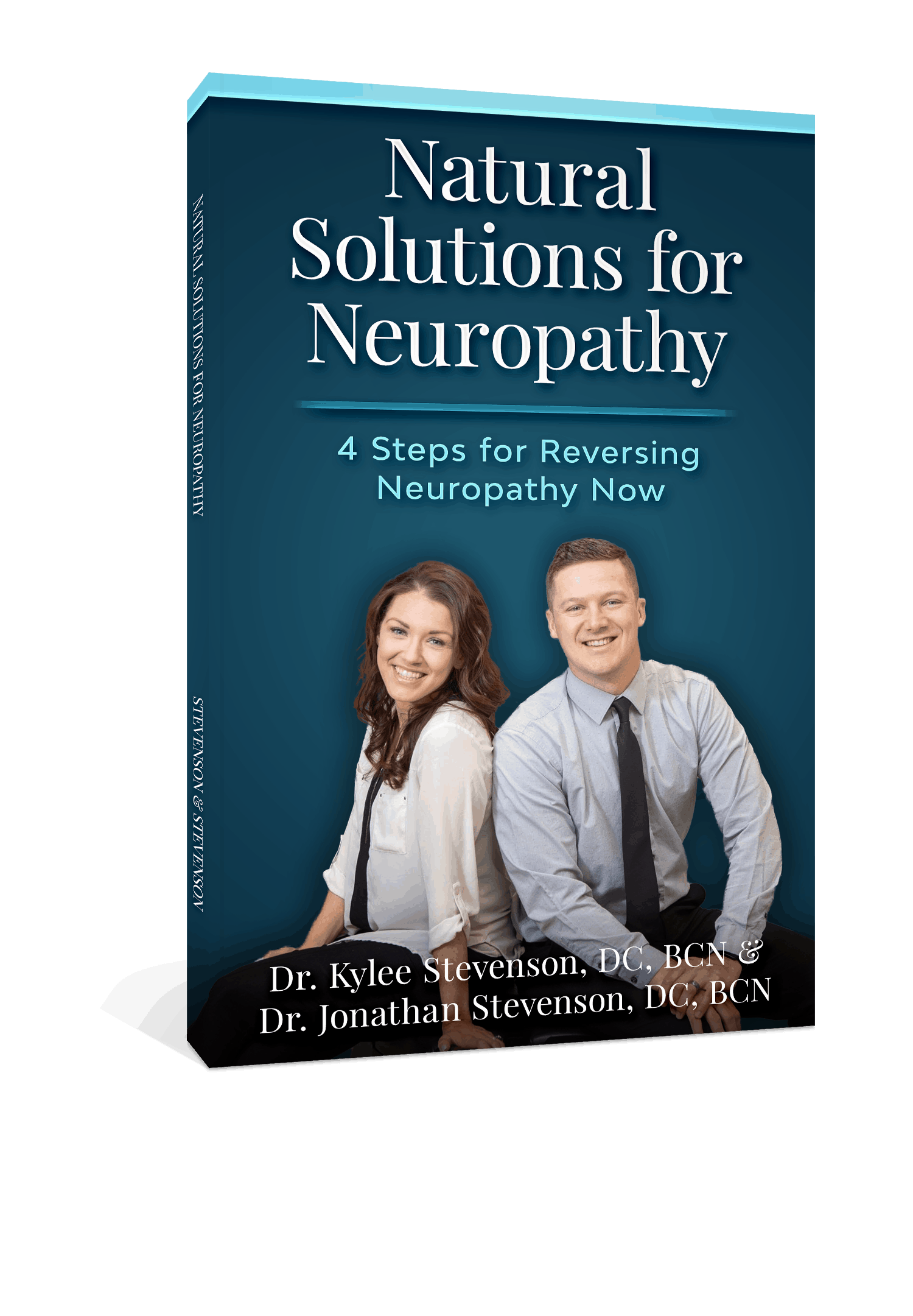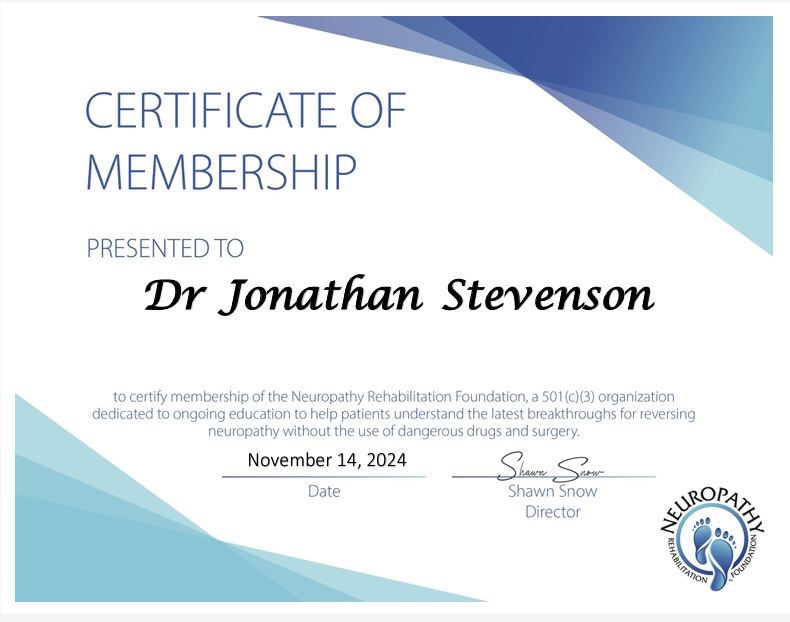Natural Solutions for Neuropathy by Drs. Kylee & Jonathan Stevenson
Brookfield Chiropractors Drs. Jon and Kylee Stevenson have published their first book:
Natural Solutions for Neuropathy- 4 Steps for Reversing Neuropathy Now.
Stop by Strive to get your copy!
Strive Chiropractic’s 9-Step Natural Neuropathy Treatment in Milwaukee
Understanding Neuropathy: Symptoms, Causes, and Treatment Options
Neuropathy is a general term meaning “nerve problem”. There are two main types of neuropathy and a variety of causes. The first type of neuropathy we will discuss has been the most common type for years but that is starting to change.
The first type is Large Fiber Mono-Neuropathy (Large Fiber meaning the bigger nerve bundles closer to the spine and Mono-meaning “one”). Large Fiber Mono-Neuropathy usually begins at the spine level, either the lower neck or lower back, and typically radiates down one arm or one leg.
The symptoms can be numbness, tingling and/or pain and most of the time will start in the shoulder or buttock region and then progressively begin to travel further down the affected arm or leg until reaching the hand/fingers or foot/toes.
The cause of this type of neuropathy is often trauma to the body like slips, falls, car accidents or other injuries that we can’t even remember and weren’t dealt with properly at the time and then start to affect us years or decades later.
The underlying cause in most cases is a problem involving the whole complex of spinal structures (muscles, ligaments, vertebrae, spinal discs) that first produces an abnormal alignment of the spine which causes pressure on the nerves which then causes the symptoms or abnormal alignment causes increased pressure on the spinal discs (shock-absorbing pads between every two spinal bones) and abnormally wears them causing a “bulging disc” which can contact the spinal nerves and cause the symptoms.
A bulging disc, if left untreated can worsen and eventually lead to a ruptured disc in which a jelly-like substance in the center of the disc (think jelly doughnut) can start to leak out and hit the nerve(s) and cause severe pain, numbness, tingling, weakness and eventually loss of muscle function (i.e. drop foot).
If this type of neuropathy is not treated early enough, it usually ends up as a surgical case.
CAUSES OF NEUROPATHY
Estimates put the number of causes for Peripheral neuropathy at over 100! Despite this number, there are only three main categories of causes.
PHYSIOLOGICAL/FUNCTIONAL CAUSES
Physiological or functional causes of neuropathy are basically health conditions that develop in the body. While there can be health conditions that develop with seemingly no cause, such as Type 1 Diabetes, these causes are typically “lifestyle diseases” that develop as a result of not giving the body what it needs to function properly, such as sufficient daily exercise or hydration, as well as overindulgence in things like food and/or alcohol. Most of these causes involve damage to the cardiovascular/circulatory system and reduce blood flow to the nerves of the lower legs and feet or lower arms and hands. Type 2 Diabetes is the most common lifestyle cause of peripheral neuropathy, however, other circulatory conditions such as heart disease, high blood pressure, congestive heart failure, and stroke can cause peripheral neuropathy as well.
CHEMICAL CAUSES
Chemical causes of peripheral neuropathy include anything that gets into the body by chance or by choice. These include medications like over-the-counter anti-inflammatories as well as statin drugs commonly used for treating high cholesterol, chemotherapy, radiation treatment, Agent Orange, prolonged and heavy alcohol and/or tobacco use, and finally, sugar. Excessive sugar consumption over time can lead to Type 2 Diabetes which is one of the most common causes of Peripheral Neuropathy.
PHYSICAL/ TRAUMATIC CAUSES
Physical or traumatic causes of neuropathy typically cause the large fiber mono-neuropathies, like sciatica, although they can contribute to the peripheral type as well as being a sole cause of peripheral neuropathy. Before continuing, let us talk about age. Neuropathy is not solely an age-related issue, because if it were then every person would develop it and would develop it at the same time. Neuropathy can affect people of all ages depending on the cause. We have treated patients as young as 28 years and our oldest was 95 when she developed neuropathy.
Typically, it’s all the things we did as kids or young adults, when we thought we were invincible, that catch up to us when we’re older.
This accumulation of stresses over time leads to degenerative conditions like Arthritis, Degenerative Disc or Joint Disease, and Spinal Stenosis which then can increase pressure on or irritate nerves and blood vessels and create these neuropathy problems.
PERIPHERAL NEUROPATHY
The second type of neuropathy is Small Fiber, Poly-Neuropathy. (Small Fiber meaning the smaller nerve bundles closer to the ends of the extremities and Poly – meaning “many” because there are many more nerves and nerve endings in these regions than there are closer to the spine).
This type is quickly becoming more and more prevalent and estimates are that it affects nearly 46.5 million Americans. This type of neuropathy is also known as Peripheral Neuropathy because it affects the nerves furthest away from the center of the body (like the lower arms, hands, fingers, lower legs, feet, and toes).
Peripheral neuropathy is a progressive condition that typically affects the lower legs and feet and then can advance to the hands and fingers. Peripheral neuropathy is characterized by a trilogy of symptoms, usually numbness and tingling, and eventually leads to debilitating balance problems. Pain is the variable with peripheral neuropathy. Some people never experience pain and for some people, pain is the first symptom to show up.
The pain of peripheral neuropathy varies from person to person. Some people have a burning type of pain. For some, it feels like electrical shocks. For others, it’s like their feet are being torn apart.
Peripheral Neuropathy is a disorder of the peripheral nerves which are nerves that go down into your arms, hands, legs, and feet.
The peripheral nerves are anything outside of the central nervous system, which is just the brain and spinal cord. So, the peripheral nerves like the ones that go down to your hands and feet are the ones that are typically affected by neuropathy.
Peripheral Neuropathy Treatment in Greater Milwaukee
Chronic inflammation, diabetes, statin drugs, degenerative conditions, and chemotherapy are often the common causes of neuropathy. Traditionally, the symptoms associated with neuropathy often involve taking medications for pain management, or even surgery. At Strive Integrative Health, we will work with you to reverse your neuropathy naturally.
Strive is conveniently located on Bluemound Road in Brookfield WI and serves nearby Southeast Wisconsin communities like Elm Grove, Waukesha, New Berlin, Pewaukee, and Milwaukee with drug-free neuropathy treatment.
WHY OUR PROGRAM?
Neuropathy is a progressive condition meaning it always get worse and never gets any better on its own. Medications do not stop the progression or even slow it down. Medication can temporarily work but then as nerve damage and symptoms get worse, increased dosage of medication is required to get the same effect as before. Well, there is a legal limit for how much medication a doctor can prescribe per day. So, what happens when you are taking the maximum per day and it no longer continues to help the symptoms? What happens when the nerve damage gets to the point of no return and the nerves can no longer regenerate and the neuropathy is permanent? The good news is our comprehensive approach to treating peripheral neuropathy addresses the underlying causes and gets the nerves regenerating and repairs the damage and as a result, the frequency and severity of the symptoms decreases significantly if not 100% eliminated.
IS OUR PROGRAM FOR YOU?
If you have been suffering and doctors and specialists tell you there is nothing that can be done our program is for you.
If you are tired of taking medication that only helps a little, if any at all, our program helps people naturally with no drugs or injections.
If your balance is getting worse our program addresses and helps improve balance and stability. Call us today.
If you are interested in finding and correcting the underlying cause of your numbness, tingling, pain and/or balance problems, then we have what you have been searching for.
If peripheral neuropathy has cost you time, sleep, money or freedom then, schedule a FREE exam today to see if we can get you feeling better, sleeping better and walking better so you can do the things you like to do or need to do and get your life back!
OUR PROGRAM GETS RESULTS!
How It Works
Imagine for a minute that you have a plant and you see that your plant is wilting. What might you do to get the plant healthy again? Well maybe you might think it needs something such as water, maybe more sunshine or maybe even some nutrients like fertilizer. These are things to think about when we see a wilting plant. If adding things does not work well maybe the plant has bugs on it or maybe it’s planted in some bad or toxic soil that might be causing it to be unhealthy.
The same principles apply to your body and your health, especially when it comes to neuropathy. We must give your body everything it needs in order to work properly. We are a living organism just like a plant and we have certain requirements that we need and if we do not get them then we start to have dysfunction and eventually dis-ease. If the nerves to your arms, hands, fingers, legs, feet or toes are not getting nutrients and growth factors from the blood then just like a plant without water to the roots, the nerves will begin to die and this then leads to the main type of peripheral neuropathy.
If a plant is wilting what would you do? Well, you give it water, sunlight and nutrients…that is exactly what we are trying to do with your nerves. We are trying to get new blood vessels and more blood to nourish the nerve back to health.
Let us dig into what that means. Neuropathy is a condition that requires a multi-pronged approach to treat the affected areas. We found that a nine-part therapy regimen that we have developed really works for treating neuropathy and each part is just as important as the others.
We found that we really need to take a comprehensive approach to treat neuropathy. It cannot be done with just simply a medication or an injection because there are so many factors that contribute to peripheral neuropathy. We take a holistic approach to treat it.
Some of the things that we do to treat neuropathy include light therapy which stimulates angiogenesis (new blood vessel formation), electrotherapy which is going to repair, rebuild, regenerate and reeducate the nerves, our metabolic management programs for blood sugar monitoring and also working on your balance, and tending to joint, nerve and muscle health in a variety of other natural ways.
All these elements come together in our comprehensive neuropathy treatment program. When we evaluate patients in our clinic, we put together a tailored program that is just for them. We determine how many clinic visits they might need and what any at-home care protocols might look like to get them better.
If it helps fix the underlying causes of neuropathy, it is in our neuropathy treatment program.
We even have a complete do it yourself at home care program for people who cannot or do not want to drive long distances for care.
Neuropathy FAQS
WHAT CAUSES NEUROPATHY?
There are many causes of peripheral neuropathy, including diabetes, chemotherapy or radiation treatments, past accidents and injuries, genetic or hereditary disorders, circulatory problems, inflammatory infections, auto-immune diseases, exposure to toxins like Agent Orange, certain prescription medications, chronic NSAID used, chronic alcoholism, kidney failure, and poor nutrition.
The good news our neuropathy correction program has a high success rate no matter the cause. Only about 3% of the people we accept for care fail to see any result. That’s a very low number so the odds are in your favor and we’ve been doing this a long time so we can usually determine during the initial neuropathy severity exam if someone is going to fall into this very low 3% population.
WHY HAVE I BEEN TOLD NOTHING CAN BE DONE FOR NEUROPATHY?
We have heard many people tell us that they were told that nothing could be done for them, they would just have to live with it, or that there’s no cure for neuropathy. Unfortunately, outside our office, that seems to be true.
Outside of what we do in our office, the only treatment options are medications (oral or injectable), physical therapy (great for muscle and joint problems but doesn’t work too well for nerve regeneration), or surgery (if they feel it’s coming from the neck or lower back.
Every day in our office, we get to witness people feeling better, sleeping better and getting their lives back because of our 9-step neuropathy correction program.
AM I A CANDIDATE?
We must first do an evaluation to be sure, but the good news is that most people are candidates for our program. The average is 2 people per month who don’t qualify because the damage is too severe, and our program wouldn’t work for them. The good news is the odds are in your favor so schedule an evaluation today so we can determine if we can help!
WILL IT HURT?
Our neuropathy treatments are painless. Some of the treatments have levels of intensity, but you are always in control of the settings so you will not select an intensity that is painful for you.
IS THE PROCEDURE SAFE?
Yes! Nothing we do in our office or have you do at home is dangerous. There are a couple rare contraindications to one or two of our treatments, but these are rare, and the vast majority can partake of all 9 steps without issue. We will determine if either of these apply to you during your initial evaluation.
HOW LONG DOES IT TAKE TO SEE RESULTS?
80% of people we choose to work with see noticeable improvement anywhere from the first treatment to within 1-2 weeks. The other 20% may take a little longer but on average notice improvement within 4-6 weeks.
CAN NEUROPATHY SYMPTOMS COME BACK?
It is possible that symptoms can come back, however, this happens when people do not follow instructions or quit when they are feeling much better. There is a tremendous difference between feeling better and healing.
Have you ever needed antibiotics for something like an ear or sinus infection? Typically, the doctor prescribes 30 pills to be taken three per day for 10 days. They tell you “even if you start feeling better before the 10 days, continue to take the pills or else…” What? That’s right! “…or else it could come back”.
The same scenario applies to neuropathy. While most people notice relief quickly, the true healing time for nerves can be 12-15 months and in cases of chemo or radiation induced neuropathy, healing can take up to 2 years.
Typically, if someone begins our program, follows instructions and carries out the treatments (mostly done at home) to allow as much of maximum healing as their body can achieve, the neuropathy will not return.
DOES MY INSURANCE COVER TREATMENT?
When you arrive for your neuropathy severity evaluation, we will collect any and all insurance information and verify coverages and benefits so that if we determine we can help, we can create your treatment plan and go over all the details during your report of findings. This report will answer the four questions everyone wants to know.
- What’s wrong
- Can we help
- How long will it take
- How much will it cost & how much does your insurance participate. Some insurance plans cover more than others.
You will have all the answers you need to decide, if we can accept your case, if you would like to begin treatment.
HOW DO I GET STARTED?
Call us to schedule your painless neuropathy severity evaluation today!




